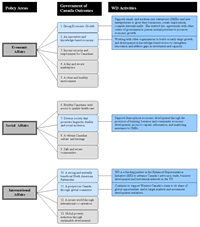Common menu bar links
Breadcrumb Trail
ARCHIVED - RPP 2006-2007
Western Economic Diversification Canada
 This page has been archived.
This page has been archived.
Archived Content
Information identified as archived on the Web is for reference, research or recordkeeping purposes. It has not been altered or updated after the date of archiving. Web pages that are archived on the Web are not subject to the Government of Canada Web Standards. As per the Communications Policy of the Government of Canada, you can request alternate formats on the "Contact Us" page.
SECTION I – OVERVIEW
Minister’s Message
 Western Canada is well positioned to be an
economic leader within Canada and in the global marketplace.
Western Canada is well positioned to be an
economic leader within Canada and in the global marketplace.
Western Economic Diversification Canada (WD) has the mandate to provide a strong federal presence in the West and to lessen Western Canada’s economic dependence on its natural resources.
In fulfilling its mandate the department works in partnership with other orders of government and organizations throughout the West, to advance its priorities.
The department’s activities and investments have been concentrated on investments in innovation, entrepreneurship and small business support.
Innovation provides an essential advantage in the increasingly competitive global economy. WD works to enhance Western Canada’s performance in this area by investing in critical stages of the innovation process.
As the source of nearly 80 per cent of all new jobs across the West, small businesses are a critical source of economic growth. WD supports entrepreneurship through the Western Canada Business Service Network, which provides direct services to help entrepreneurs in urban and rural communities to create and grow their businesses.
The department has also increased its emphasis on international trade and investment to ensure that the West can compete with the best that the world has to offer. For example, WD is working to improve access to the large and fast-growing markets of Asia.
Another important role for WD is strengthening communities by developing cost-shared arrangements and delivering initiatives in partnership with other orders of government. These arrangements include the Western Economic Partnership Agreements and infrastructure agreements, designed to meet regional needs while fostering a higher quality of life in western communities.
Since my appointment as Minister of Western Economic Diversification, I have had the opportunity to review the range of programs and projects delivered by the department.
I have met with government and business representatives during my visits to the four western provinces. I have been consulting with Cabinet and caucus colleagues and senior departmental officials on the role and priorities of the government and WD in supporting economic growth and development in the West. I have also undertaken a series of external consultations with western Canadian business and community leaders to obtain their views on the role, activities and future directions of WD.
Based on what I have learned about the important work, opportunities and issues facing this department, I believe there is more work to be done. We can build on the successes of WD by enhancing the role that this regional economic agency plays in supporting long-term economic growth, diversification, and the development of the West.
It is clear that we all share a commitment to strengthen the economic growth of Western Canada and to rebuild trust in public administration. I am confident that we will meet the expectations of our government for transparency and full fiscal accountability to Canadians.
On behalf of Canada’s new government, my focus as the Minister of Western Economic Diversification is to ensure that the department is a productive partner in helping the West achieve its full economic potential by building on our strengths in regional development policy.
In order to ensure a productive and competitive economy not just for today, but for the future, WD’s policies and programs must continue to evolve in order to meet the needs of an ever-changing and growing West.
I look forward to sharing the results of our visioning consultations for Western Economic Diversification Canada.
The Honourable Carol Skelton, P.C., M.P.
Minister of National Revenue and
Minister of Western Economic Diversification
Management Representation Statement
I submit for tabling in Parliament, the 2006-2007 Report on Plans and Priorities (RPP) for
Western Economic Diversification Canada.
This document has been prepared based on the reporting principles contained in Guide for the Preparation of Part III of the 2006-2007 Estimates: Reports on Plans and Priorities and Departmental Performance Reports:
- it adheres to the specific reporting requirements outlined in the Treasury Board Secretariat (TBS) guidance;
- it is based on the department’s approved Program Activity Architecture structure as reflected in its Management Resources and Results Structure (MRRS);
- it presents consistent, comprehensive, balanced and accurate information;
- it provides a basis of accountability for the results achieved with the resources and authorities entrusted to it; and
- it reports finances based on approved planned spending numbers from the Treasury Board Secretariat in the RPP.
Oryssia J. Lennie
Deputy Minister
Western Economic Diversification Canada
Summary Information
|
Raison D’être – Western Economic Diversification Canada (WD) was established in 1987 to lessen the West’s (British Columbia, Alberta, Saskatchewan and Manitoba) strong economic dependence on its natural resources. Under the Western Economic Diversification Act, 1988, the department is mandated to: “promote the development and diversification of the economy of Western Canada and to advance the interests of Western Canada in national economic policy, program and project development and implementation.” Regional development policies and programs are an important part of a comprehensive strategy to ensure that Canada’s regions benefit from the opportunities of the new global economy. WD will continue to work closely with many partners to help SMEs compete and prosper in the global marketplace. WD relies upon its strong relationships with provincial governments, municipalities, universities and local business and community economic development organizations to advance its three distinct, but interrelated strategic directions – innovation, entrepreneurship and community economic development. |
| 2006-2007 | 2007-2008 | 2008-2009 |
|---|---|---|
| $354,236 | $231,602 | $182,279 |
| 2006-2007 | 2007-2008 | 2008-2009 |
|---|---|---|
| 390 | 383 | 383 |
| Priority | Type | Planned Spending* ($ millions) | |||
|---|---|---|---|---|---|
| 2006-2007 | 2007-2008 | 2008-2009 | |||
|
The following two management priorities support all of WD’s strategic outcomes |
|||||
|
Implement a modern management agenda that focuses on improving management practices within the department including strengthening accountability to Canadians, integration of human resource planning with business planning, follow-up on the employee survey, and improving information management. |
Ongoing |
Program Activity – N/A Expected Result – Compliance with relevant Acts and Policies, clear accountabilities, integrated planning, and increased efficiency and effectiveness. |
N/A | N/A | N/A |
|
Implement changes to WD’s Strategic Framework resulting from WD’s consultations with western stakeholders. |
New |
Program Activity – N/A Expected Result – Revised strategic outcomes for WD focused on supporting economic and business activities that have clear economic benefits for Western Canada. |
N/A |
N/A |
N/A |
*Costs associated with these priorities are operating and maintenance (O&M) costs only and relate primarily to time spent by departmental officials.
For the current year, the department has limited its priorities to the two identified above. Over the summer, the Minister and the department undertook consultations with stakeholders across the West to examine WD’s strategic outcomes and priorities, and to discuss options for refocusing WD’s strategic directions. Once the outcome of this visioning exercise is finalized, priorities will be determined and implementation of them will begin to occur in the current fiscal year. WD’s 2007 – 2008 Report on Plans and Priorities will fully reflect any revisions to WD’s strategic directions.
Departmental Plans and Priorities
WD’s Planning Environment
The Rationale for Regional Development
Regional development has been an integral part of Canadian economic and industrial policy for many decades. Reflecting its importance as an essential part of Canada’s federal system of government, regional development policy and objectives are entrenched in Section 36 of the Constitution Act, 1982, which commits the federal and provincial governments to:
- promoting equal opportunities for the well-being of Canadians, and
- furthering economic development to reduce disparity in opportunities.
The need for regional development is rooted in the recognition that Canada is a vast and diverse country made up of a number of regions with distinct socio-economic characteristics, industrial structure and varying economic potential. Historically, the emphasis of regional development was on reducing the economic disparities between provinces. The federal government provided regional development programs on a national basis and delivered them through departments with national mandates and structures.
More recently, the emphasis has shifted towards the development of economic opportunities and regionally tailored approaches. This regional approach resulted in the creation of a number of regional development agencies (RDAs), of which WD, through the Western Economic Diversification Act, 1988 is responsible for economic diversification and development in the four western provinces, British Columbia (BC), Alberta (AB), Saskatchewan (SK), and Manitoba (MB).
Western Challenges and Opportunities - the WD Response
It is important to recognize that there are considerable differences in the composition and performance of the four western provincial economies. For several years, the economic performance of Western Canada’s economy has been strong, largely driven by high demand and market prices for many of the natural resources that have traditionally anchored the western economy: softwood lumber, crude oil, natural gas, minerals, and hydroelectricity. As a result, all four western provinces have experienced economic growth, albeit at significantly different rates. Alberta clearly has experienced the strongest growth, regionally as well as nationally, followed by British Columbia. These two provinces also attract many immigrants from abroad and are the target destination for many Canadians in search of jobs and high living standards. Based on the latest Statistics Canada census, the Edmonton-Calgary corridor is the fastest growing population area in Canada.
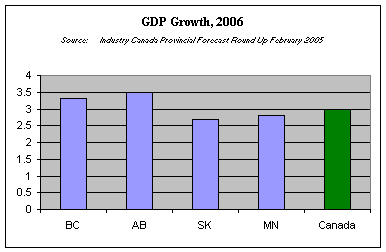 While British Columbia and Alberta are among the
economic leaders in Canada, economic growth rates in Saskatchewan and Manitoba have been more modest. Saskatchewan’s growth has been robust enough in recent years
that it is currently enjoying the status of a “have” province in Confederation, mainly due to increased revenues generated from high world oil prices. Both
Manitoba and Saskatchewan have small and stable or slightly declining population bases and the growth in their highest performing sectors (minerals and heavy oil in
Saskatchewan, hydro-power and manufacturing in Manitoba) is counterbalanced by continued difficulties in the agricultural sector.
While British Columbia and Alberta are among the
economic leaders in Canada, economic growth rates in Saskatchewan and Manitoba have been more modest. Saskatchewan’s growth has been robust enough in recent years
that it is currently enjoying the status of a “have” province in Confederation, mainly due to increased revenues generated from high world oil prices. Both
Manitoba and Saskatchewan have small and stable or slightly declining population bases and the growth in their highest performing sectors (minerals and heavy oil in
Saskatchewan, hydro-power and manufacturing in Manitoba) is counterbalanced by continued difficulties in the agricultural sector.
With much of the recent strong economic performance throughout a lot of Western Canada tied to a current resource driven boom, the West continues to face a number of challenges, which need to be addressed to ensure the long-term economic sustainability of the region. These challenges underlie WD’s strategic planning and priorities in pursuit of its legislative mandate.
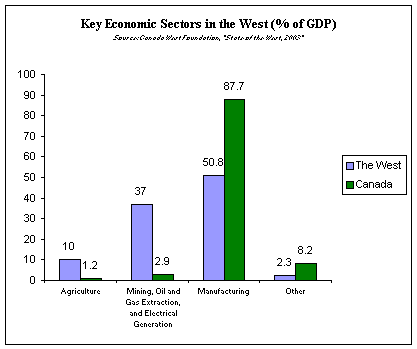 Given that the West is a
relatively small player in the world commodity markets, its economic fortunes wax and wane in accordance with the volatility typical for natural resource markets. The
current economic boom in the West is the most recent of several, which are typically driven by resource extraction and export. However, the West’s reliance on
natural resources has also resulted in several significant economic downturns. At times, these have taken a severe toll on the West’s economy and its society.
Given that the West is a
relatively small player in the world commodity markets, its economic fortunes wax and wane in accordance with the volatility typical for natural resource markets. The
current economic boom in the West is the most recent of several, which are typically driven by resource extraction and export. However, the West’s reliance on
natural resources has also resulted in several significant economic downturns. At times, these have taken a severe toll on the West’s economy and its society.
The resource-based economy of Western Canada faces other significant challenges including the continuing decline of the rural economy and exposure to serious disruptions due to trade disputes (such as softwood lumber) or disasters, which severely affect certain commodity sectors (the Mountain Pine Beetle infestation, Bovine Spongiform Encephalopathy (BSE), and the flooding of agricultural farmland).
| The ongoing challenge: develop and diversify the western economies to reduce reliance on primary resources |
Being a small player on a very large world stage, the ongoing challenge for the western Canadian economy is to develop in such a way that it can successfully compete globally on a long-term sustainable level, create wealth, and be able to maintain or increase the current standard of living in the region. The current strong performance of resource driven sectors provides the opportunity and the need to encourage public and private investment to continue to diversify the economic base, hasten the transition to knowledge-driven industries, and increase the value-added and market penetration of western goods, services, and technologies. WD works in collaboration with provincial and municipal governments, other federal departments, industry associations and the private sector, not-for-profit organizations, and research organizations, to jointly invest in projects that ultimately result in diversification and further development to maximize the core natural resource strengths of the West.
Innovation and technology are key factors in the West’s economic development and diversification. They offer the potential for improved productivity in the primary resource sector. Innovation and technology will also make the West more competitive in the production and trade of value-added goods and services related to its natural resources. Looking beyond the traditional resource sectors, investments and policy approaches that promote innovation and technology growth and development will help all four western provinces capitalize on the emergence of knowledge-based industries such as the life sciences, environmental technologies, and information communications technology (ICT). WD works with organizations to jointly invest in projects in the life sciences/health innovation, environmental technologies, information and communications technology/wireless and new media sectors.
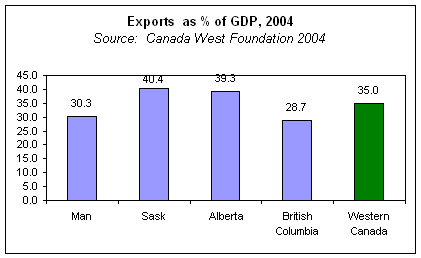 Canada is a trading nation, and in Western
Canada, 35 per cent of our gross domestic product (GDP) is trade dependent. A strategy for ensuring long-term growth and development in the West needs to pay attention to
international trade and investment. Being heavily trade dependent, it is crucial that western Canadian businesses, research institutions, and communities
remain internationally competitive. Access to the US market will continue to be extremely important, but there are also very large challenges and opportunities for western
businesses in some emerging international markets, such as China and India. While there is currently high and increasing demand in these economies for raw materials,
demand for manufactured goods is also expected to grow as incomes and standards of living improve. The western Canadian economies are challenged to position themselves
competitively so they can benefit from these trends and capitalize on a growing capacity in research, innovation, and commercialization. In 2006-2007, WD plans to
concentrate on supporting Canada’s Asia-Pacific Gateway and Corridor Initiative and increasing western Canadian awareness of, and access to, promising new
Asia-Pacific markets. The department also plans to expand the range of information, advisory and market development tools and services available within the West so that
western Canadian industries and research organizations can take advantage of the US Enhanced Representation Initiative (ERI).
Canada is a trading nation, and in Western
Canada, 35 per cent of our gross domestic product (GDP) is trade dependent. A strategy for ensuring long-term growth and development in the West needs to pay attention to
international trade and investment. Being heavily trade dependent, it is crucial that western Canadian businesses, research institutions, and communities
remain internationally competitive. Access to the US market will continue to be extremely important, but there are also very large challenges and opportunities for western
businesses in some emerging international markets, such as China and India. While there is currently high and increasing demand in these economies for raw materials,
demand for manufactured goods is also expected to grow as incomes and standards of living improve. The western Canadian economies are challenged to position themselves
competitively so they can benefit from these trends and capitalize on a growing capacity in research, innovation, and commercialization. In 2006-2007, WD plans to
concentrate on supporting Canada’s Asia-Pacific Gateway and Corridor Initiative and increasing western Canadian awareness of, and access to, promising new
Asia-Pacific markets. The department also plans to expand the range of information, advisory and market development tools and services available within the West so that
western Canadian industries and research organizations can take advantage of the US Enhanced Representation Initiative (ERI).
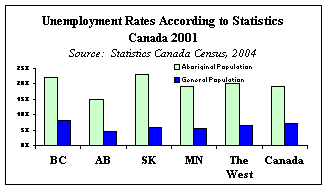 The
competitiveness of western Canadian business is also facing a mounting challenge in terms of the supply of skilled labour. As the western Canadian economy develops and
grows, the demand for skilled labour has increased. This has occurred in the face of increasing global competition for skilled employees, management, and
researchers across a range of sectors. The western provinces are facing severe labour shortages in many of the sectors on which the region’s and Canada’s
strong economic performance depends. While the resource based growth and investments in Western Canada are often perceived to be limited to Alberta and BC, the economic
and business expansion presented by major investments in oil and gas facility expansion, and the potential growth in trade and services with the rising economic powers of
the Asia-Pacific through the Pacific Gateway, offer new business, trade, and employment opportunities for all regions of Canada.
The
competitiveness of western Canadian business is also facing a mounting challenge in terms of the supply of skilled labour. As the western Canadian economy develops and
grows, the demand for skilled labour has increased. This has occurred in the face of increasing global competition for skilled employees, management, and
researchers across a range of sectors. The western provinces are facing severe labour shortages in many of the sectors on which the region’s and Canada’s
strong economic performance depends. While the resource based growth and investments in Western Canada are often perceived to be limited to Alberta and BC, the economic
and business expansion presented by major investments in oil and gas facility expansion, and the potential growth in trade and services with the rising economic powers of
the Asia-Pacific through the Pacific Gateway, offer new business, trade, and employment opportunities for all regions of Canada.
Strong cooperation between industry and all orders of government will be required to ensure that the region’s labour market conditions are conducive to attracting workers to meet a variety of needs. Emphasis must also be given to increasing support for initiatives that focus on training and skills development, matching industry needs with available labour supply, and looking at opportunities to adopt new technologies and business practices to improve business productivity. Given that Aboriginal people are the youngest and fastest growing population group in Canada, the increased participation of Aboriginal youth in the western labour market would address a number of issues, ranging from meeting the demand for skilled labour to addressing some of the persistent economic and social challenges experienced by Canada’s Aboriginal peoples.
WD is working with industry, sector associations, provincial governments and other federal departments to identify gaps and opportunities where WD can play a role in helping to address skilled labour shortages. The department has provided support for graduate internship programs and Aboriginal apprenticeship programs where the focus is on increasing the skills and number of knowledge workers in the West. Through these collaborative arrangements with many partners, WD continues to focus on niche opportunities that maximize its investment.
Economically strong and viable cities and communities are an essential contributor to international competitiveness and the attraction of skilled workers, investment and new businesses. Urbanization will continue in Canada’s West as everywhere else, and modern and efficient infrastructure is necessary to the West’s international competitiveness. This is a massive undertaking, and no single order of government or other stakeholder has the capacity to address it in isolation. There is an increased recognition in Canada and elsewhere that the complexities of urbanization require collaboration and the pooling of resources to ensure success. WD has been a pioneer in the development and management of horizontal collaborative initiatives in western Canadian cities through mechanisms such as joint investment in innovation centres, R&D infrastructure, and the tripartite urban development agreements.
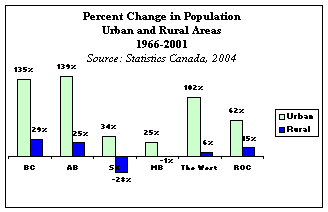 As
urbanization increases, rural communities are faced with significant adjustments, as they struggle with the loss of population and economic opportunity.
Governments and stakeholders are challenged to examine constructive approaches to these pressures including improving access of rural communities to business services and
capital pools and working in partnership to create new business opportunities.
As
urbanization increases, rural communities are faced with significant adjustments, as they struggle with the loss of population and economic opportunity.
Governments and stakeholders are challenged to examine constructive approaches to these pressures including improving access of rural communities to business services and
capital pools and working in partnership to create new business opportunities.
This Report on Plans and Priorities (RPP) demonstrates that WD’s plans and priorities are aligned with these challenges and that the department is positioned to make a significant contribution to meeting them. Combined with the annual Departmental Performance Report, which provides detailed information on the department’s spending and achievements, these documents demonstrate that WD is actively pursuing a long-range set of policies and investments that are having a positive impact on the economic performance and competitiveness of Western Canada.
WD’s Operating Environment
To deliver on its mandate, WD targets three inter-related policy areas – innovation, entrepreneurship and community economic development. The department’s policy, advocacy and coordination function is also integral to WD’s contribution to the western economy.
In 1995, WD moved away from providing funding and service support directly to entrepreneurs. WD directs its core resources towards working in collaboration with many partners including all levels of government, universities, financial institutions, the private sector, and the not-for-profit sector.
WD works with the Western Canada Business Service Network (WCBSN) to ensure that western Canadians have access to capital and services that support their economic success. WD provides operating funding to each of the members1, who in turn provide business information, counselling and planning advice to entrepreneurs in both urban and rural communities across the West. Some members also provide loans and undertake a variety of community economic development initiatives to provide grassroots solutions to local problems.
WD delivers a wide range of activities, either directly through programs like the Western Diversification Program (WDP), or in partnership with others such as the federal-provincial Western Economic Partnership Agreements (WEPAs). WD also plays an important role in coordinating and supporting multi-partner projects to promote economic development objectives – such as through Urban Development Agreements (UDAs) in several western Canadian cities, the Urban Aboriginal Strategy (UAS), or industry-academic collaborations such as WestLink Innovation Network Ltd. or the Telecommunications Research Laboratories (TRLabs). WD also plays a strong role within the federal government in advocating on behalf of western Canadian priorities and interests, promoting policy initiatives such as the Asia-Pacific Gateway and Corridor Initiative and stronger cross-border linkages with the United States. In all cases, WD provides western Canadians with a strong federal presence within Western Canada that is knowledgeable about local capacity and needs, and can work directly with individuals and organizations within the region to ensure federal policy and programs takes these into account.
| Partnerships with others to increase leveraging |
In making funding decisions, WD relies upon the knowledge, advice and support of its extensive network of provincial, university, private sector and not-for-profit partners and client organizations to identify needs and opportunities, and to jointly develop projects and new initiatives that advance shared objectives. By working in close collaboration with others, WD leverages both capacity and financing. WD’s decision making on project funding is both open and transparent. Potential project applicants may approach WD for funding, or WD, through its extensive network of partners, may identify an opportunity and organization, and work with that organization as they develop a business plan for further review by the department. Funding program guidelines are posted on WD’s website at http://www.wd.gc.ca/programs/default-eng.asp.
After due diligence is undertaken to confirm applicant eligibility, anticipated project results and fit with WD’s strategic outcomes, project or applicant viability, and identification of other funding sources, the project undergoes significant scrutiny and challenge at various levels within WD before being either approved or rejected by the delegated level of authority.
| Transparency and due-diligence in decision-making |
WD has a strong public service values and ethics program, and operates in an open and transparent manner. The department has in place formal management accountability and performance frameworks and measures to ensure that:
- appropriate due diligence is exercised in the assessment, approval and monitoring of grants and contributions (G&C) investments;
- resources are deployed, managed and clearly linked to departmental objectives and priorities, planned spending and expected results; and
- departmental performance is regularly assessed and reported on through a variety of mechanisms.
| Accountability |
Internally, the department is undertaking a number of initiatives designed to strengthen governance and accountability. WD has a defined governance structure that outlines decision-making mechanisms, responsibilities, and accountabilities within the department. WD’s strategic outcomes are aligned with the Whole of Government Framework and give a clear indication of the long-term goals of the department. Regional and corporate unit plans support the department’s strategic outcomes. The department has established a strong business planning function to support priority setting and investment decisions. In the coming year, WD will refine its planning process to integrate human resource planning into all regional and corporate plans.
Starting in the spring of 2006 and continuing on into the summer, the Minister held a series of roundtables with key stakeholders across the West to examine how WD’s current strategic outcomes and priorities could be re-focused to better respond to the challenges and opportunities facing the West today. During this period, the department continued to manage its current portfolio of projects and contribution agreements. Results from the stakeholder consultations will be reflected in the department’s 2007-2008 RPP.
Alignment With Whole of Government Framework
WD’s strategic outcomes and activities are aligned with the Whole of Government Framework, as follows:

